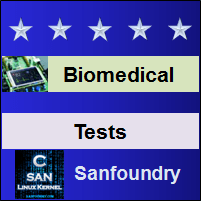 Our Biomedical Instrumentation Tests allow you to experience an online examination in the real-time environment. In every online test on Biomedical Instrumentation, you will be presented with Multiple Choice Questions (MCQs) which will test your skills in Biomedical Instrumentation Concepts in a detailed and comprehensive manner. In the test, each question will have 4 options to choose from. You should select only 1 correct option as an answer and then move on to the next question. Once you submit answers to all the questions, you will be given your final test score.
Our Biomedical Instrumentation Tests allow you to experience an online examination in the real-time environment. In every online test on Biomedical Instrumentation, you will be presented with Multiple Choice Questions (MCQs) which will test your skills in Biomedical Instrumentation Concepts in a detailed and comprehensive manner. In the test, each question will have 4 options to choose from. You should select only 1 correct option as an answer and then move on to the next question. Once you submit answers to all the questions, you will be given your final test score.In the Online Biomedical Instrumentation Test, for every correct answer, you will be given 2 points. There will also be negative marking of -1 for every wrong answer. So, you will have to be more careful in choosing the answers to the question in your online examination. If needed, you should skip to the next question and come back to the previous question later so that you can do proper time management for the online mock tests.
Based on your score, you would be given one of the following Grades:
Grade A* - Genius (You scored 100%)
Grade A - Excellent (Your score is in the range of 80% to 99%)
Grade B - Good (Your score is in the range of 60% to 80%)
Grade C - Average (Your score is in the range of 40% to 60%)
Grade D - Poor (Your score is in the range of 0% to 40%)
There will be 5 types of Biomedical Instrumentation Tests. The details of each of these tests are as follows:
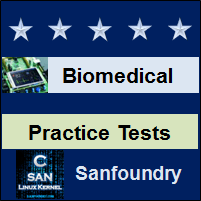 1. "Biomedical Instrumentation Practice Tests 1-10" - In Biomedical Instrumentation practice tests, there will be a series of practice tests wherein you can test your Biomedical Instrumentation concepts on every chapter separately. There are totally 10 different chapters on this subject and hence there will be 10 different practice tests wherein each practice tests covers one chapter exclusively. There will not be any time limit on these tests. So, Biomedical Instrumentation Practice Tests should be the first set of tests which you should attempt. Goto these practice tests here.
1. "Biomedical Instrumentation Practice Tests 1-10" - In Biomedical Instrumentation practice tests, there will be a series of practice tests wherein you can test your Biomedical Instrumentation concepts on every chapter separately. There are totally 10 different chapters on this subject and hence there will be 10 different practice tests wherein each practice tests covers one chapter exclusively. There will not be any time limit on these tests. So, Biomedical Instrumentation Practice Tests should be the first set of tests which you should attempt. Goto these practice tests here.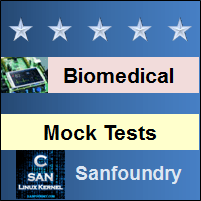 2. "Biomedical Instrumentation Mock Tests 1-10" - In Biomedical Instrumentation mock tests, there will be a series of mock tests wherein you can test your Biomedical Instrumentation concepts on every chapter separately, but there will be a fixed time limit per mock test. Here also, there are 10 mock tests wherein each mock test covers only one chapter exclusively. So, it is similar to Biomedical Instrumentation Practice Tests, but with an added constraint of time limits. You should try Biomedical Instrumentation Mock Tests if you are appearing for any online examination soon. Goto these mock tests here.
2. "Biomedical Instrumentation Mock Tests 1-10" - In Biomedical Instrumentation mock tests, there will be a series of mock tests wherein you can test your Biomedical Instrumentation concepts on every chapter separately, but there will be a fixed time limit per mock test. Here also, there are 10 mock tests wherein each mock test covers only one chapter exclusively. So, it is similar to Biomedical Instrumentation Practice Tests, but with an added constraint of time limits. You should try Biomedical Instrumentation Mock Tests if you are appearing for any online examination soon. Goto these mock tests here.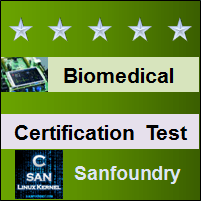 3. "Biomedical Instrumentation Certification Test" - Once you are thorough with your Biomedical Instrumentation concepts, then you can try our Biomedical Instrumentation Certification Test wherein your name will be mentioned in Top Rankers list, if you scored either Grade A* or Grade A in the Biomedical Instrumentation Certification Test. The Certification Test is free. Goto Biomedical Instrumentation Certification test here.
3. "Biomedical Instrumentation Certification Test" - Once you are thorough with your Biomedical Instrumentation concepts, then you can try our Biomedical Instrumentation Certification Test wherein your name will be mentioned in Top Rankers list, if you scored either Grade A* or Grade A in the Biomedical Instrumentation Certification Test. The Certification Test is free. Goto Biomedical Instrumentation Certification test here. 4. "Biomedical Instrumentation Internship Test" - If you are interested to do Internships in Biomedical Instrumentation at Sanfoundry, then you must take our Biomedical Instrumentation Internship Test. If you scored either Grade A* or Grade A in Biomedical Instrumentation Internship Test, then you are eligible for Internship at Sanfoundry in Biomedical Instrumentation. Goto Biomedical Instrumentation Internship test here.
4. "Biomedical Instrumentation Internship Test" - If you are interested to do Internships in Biomedical Instrumentation at Sanfoundry, then you must take our Biomedical Instrumentation Internship Test. If you scored either Grade A* or Grade A in Biomedical Instrumentation Internship Test, then you are eligible for Internship at Sanfoundry in Biomedical Instrumentation. Goto Biomedical Instrumentation Internship test here.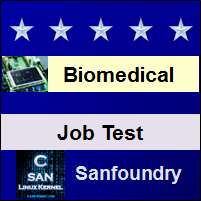 5. "Biomedical Instrumentation Job Test" - If you are a fresher, a dropout, an experienced person and if you know Biomedical Instrumentation well and looking out for jobs in Biomedical Instrumentation domain at Sanfoundry (or our Network of Companies), then you should try and qualify our "Biomedical Instrumentation Job Test". If you scored either Grade A* or Grade A in Biomedical Instrumentation Job Test, then you are eligible for a Job at Sanfoundry (or our Network) in Biomedical Instrumentation domain. Kindly note that you can repeat this job test after a gap of 30 days from the day of last attempt of the test. Goto Biomedical Instrumentation Job test here.
5. "Biomedical Instrumentation Job Test" - If you are a fresher, a dropout, an experienced person and if you know Biomedical Instrumentation well and looking out for jobs in Biomedical Instrumentation domain at Sanfoundry (or our Network of Companies), then you should try and qualify our "Biomedical Instrumentation Job Test". If you scored either Grade A* or Grade A in Biomedical Instrumentation Job Test, then you are eligible for a Job at Sanfoundry (or our Network) in Biomedical Instrumentation domain. Kindly note that you can repeat this job test after a gap of 30 days from the day of last attempt of the test. Goto Biomedical Instrumentation Job test here.For every "Biomedical Instrumentation Practice Test", Total Questions: 20, Total Time: Unlimited.
For every "Biomedical Instrumentation Mock Test", Total Questions: 20, Total Time: 20 Minutes.
For "Biomedical Instrumentation Certification Test", Total Questions: 50, Total Time: 1 hour.
For "Biomedical Instrumentation Internship Test", Total Questions: 50, Total Time: 1 hour.
For "Biomedical Instrumentation Job Test", Total Questions: 50, Total Time: 1 hour.
Before you get started on these series of online tests on Biomedical Instrumentation, you should learn, study and practice our collection of 1000 MCQs (Multiple Choice Questions and Answers) on Biomedical Instrumentation here. We also prefer that you should practice Biomedical Instrumentation practice tests and mock tests completely before attempting the certification test.
Here is the list of online practice tests and mock tests on Biomedical Instrumentation. Each online test focuses on a "Specific chapter of Biomedical Instrumentation". So, you should try both practice test and mock test on every chapter to do a self-assessment of your knowledge (along with time-limit constraints) in every area or sub-topic of Biomedical Instrumentation. Biomedical Instrumentation Certification test, Internship test, and Job Test are mentioned at the end of this list.
1. Biomedical Instrumentation Test 1 – This set of online test on “Biomedical Instrumentation” tests your skills on Origin of Bioelectric Signals, Recording Electrodes, Silver-Silver Chloride Electrodes, Electrodes for ECG, Electrodes for EMG, Electrodes for EEG, Microelectrodes, Classification of Transducers, Performance Characteristics of Transducers, Displacement, Position and Motion Transducers.
2. Biomedical Instrumentation Test 2 – This set of online test on “Biomedical Instrumentation” tests your skills on Pressure Transducers, Transducers for Body Temperature Measurement, Photoelectric Transducers, Optical Fiber Sensors, Biosensors, Smart Sensors, General Considerations for Signal Conditioners, Preamplifiers, Sources of Noise in Low Level Measurements, Biomedical Signal Analysis and Processing Techniques.
3. Biomedical Instrumentation Test 3 – This set of online test on “Biomedical Instrumentation” tests your skills on The Main Amplifier and Driver Stage, Writing System, Direct Writing Recorders, The Inkjet Recorders, Potentiometric Recorder, Digital Recorders, Video Printers, Electrocardiography, Vectorcardiography (VCG), Phonocardiography (PCG).
4. Biomedical Instrumentation Test 4 – This set of online test on “Biomedical Instrumentation” tests your skills on Digital Stethoscope, Electroencephalograph (EEG), Electromyograph (EMG), Other Biomedical Recorders, Biofeedback Instrumentation, System Concepts, Cardiac Monitor, Bedside Patient Monitoring System.
5. Biomedical Instrumentation Test 5 – This set of online test on “Biomedical Instrumentation” tests your skills on Central Monitors, Measurement of Heart Rate, Measurement of Temperature, Measurement of Respiration Rate, Catheterization Laboratory Instrumentation, Cardiac Arrhythmias, Arrhythmias Monitor.
6. Biomedical Instrumentation Test 6 – This set of online test on “Biomedical Instrumentation” tests your skills on QRS Detection Techniques, Data Compression Techniques, Exercise Stress Testing, Ambulatory Monitoring Instruments, Cardiotocograph, Methods of Monitoring Foetal Heart Rate – 1, Methods of Monitoring Foetal Heart Rate – 2, Monitoring Labour Activity, Recording System.
7. Biomedical Instrumentation Test 7 – This set of online test on “Biomedical Instrumentation” tests your skills on Oximeters, Ear Oximeter, Pulse Oximeter, Skin Reflectance Oximeters, Intravascular Oximeters, Mechanism of Hearing, Measurement of Hearing.
8. Biomedical Instrumentation Test 8 – This set of online test on “Biomedical Instrumentation” tests your skills on Biotelemetry, Single Channel Telemetry System, Multi-Channel Wireless Telemetry System, Multi-Patient Telemetry, Implantable Telemetry Systems, Biotelemetry Application on Wimax Networks, Transmission of Analog Physiological Signals Over Telephone.
9. Biomedical Instrumentation Test 9 – This set of online test on “Biomedical Instrumentation” tests your skills on Essential Parameters for Telemedicine, Delivery Models in Telemedicine, Telemedicine System, Clinical Data Interchange/Exchange Standards, Transmission of Still Images, Transmission of Video Images, Transmission of Digital Audio.
10. Biomedical Instrumentation Test 10 – This set of online test on “Biomedical Instrumentation” tests your skills on Cyber Medicine, Application of Telemedicine, PACS (Picture Archiving and Communication System), Pulmonary Function Measurement, Spirometry, Pneumotachometers, Measurement of Volume, Pulmonary Function Analysers, Respiratory Gas Analysers, Medical Diagnosis with Chemical Tests.
Sanfoundry will issue a Certificate of Merit to Top 5 Rankers for a given month provided that they have scored either A* or A Grade in the Contest. If you are interested, then kindly register below. After registration, you can take the test anytime (24x7).
